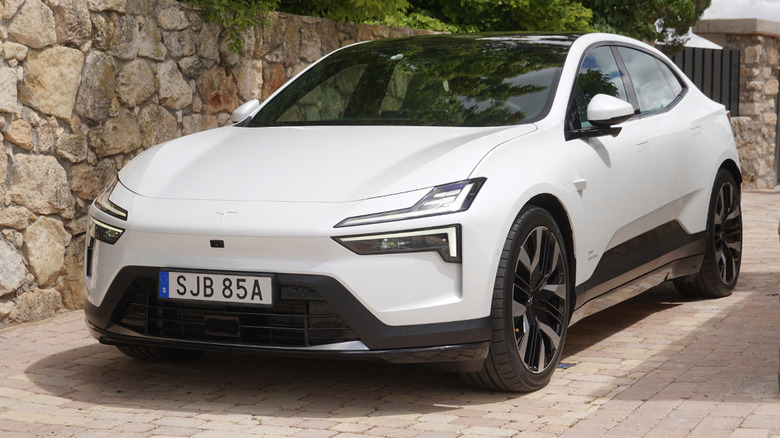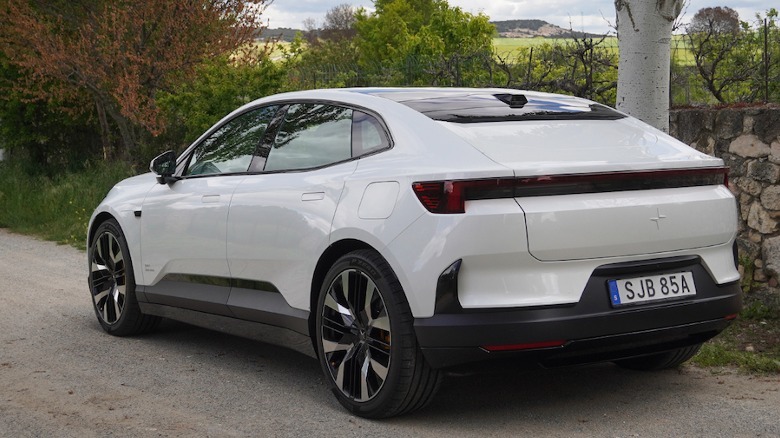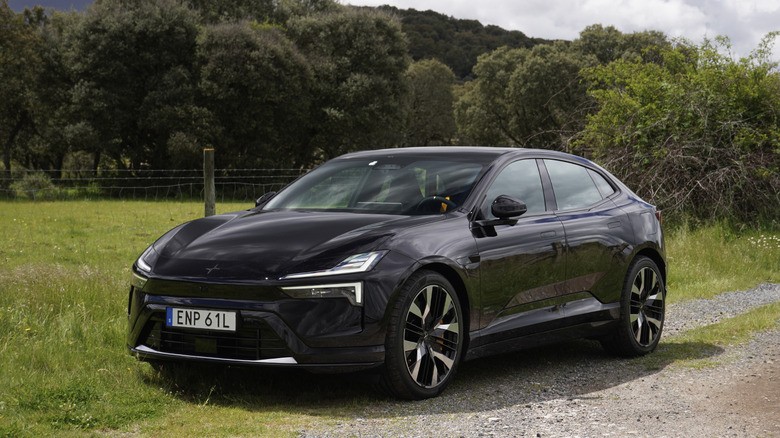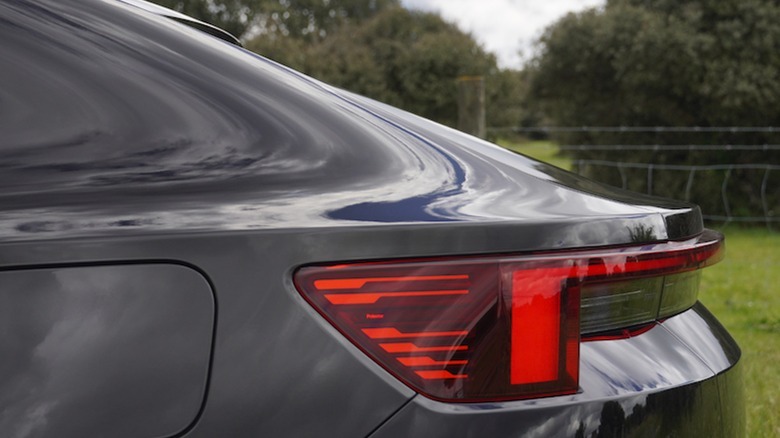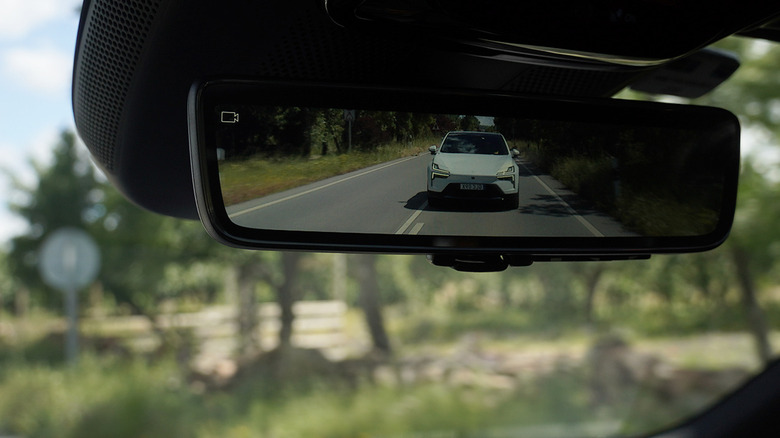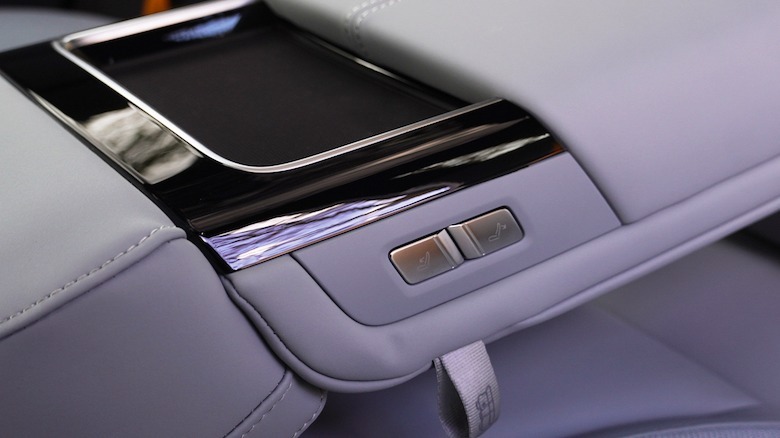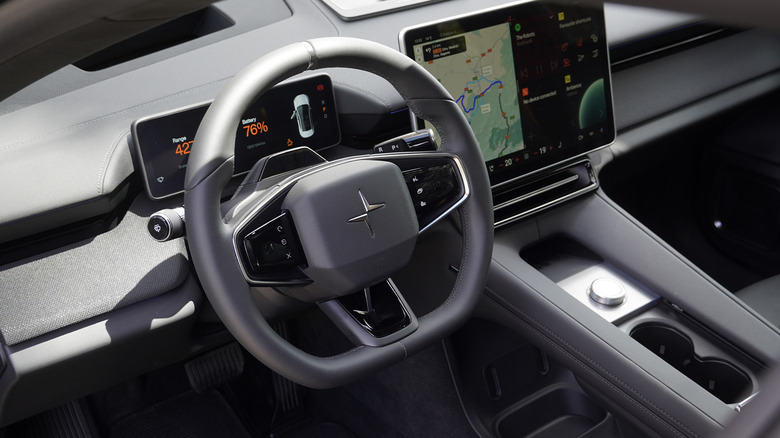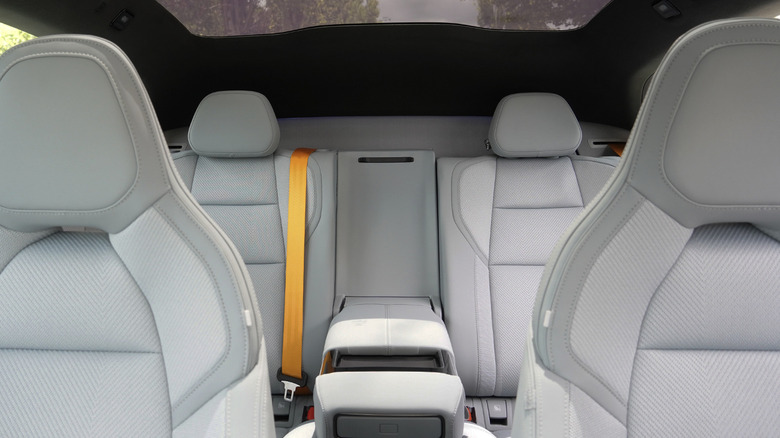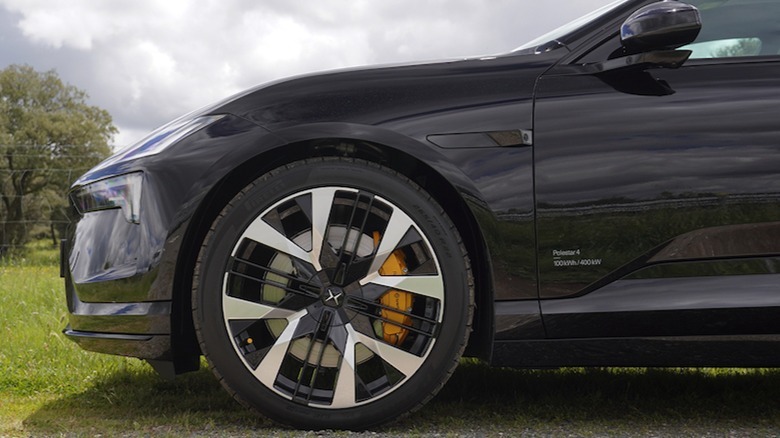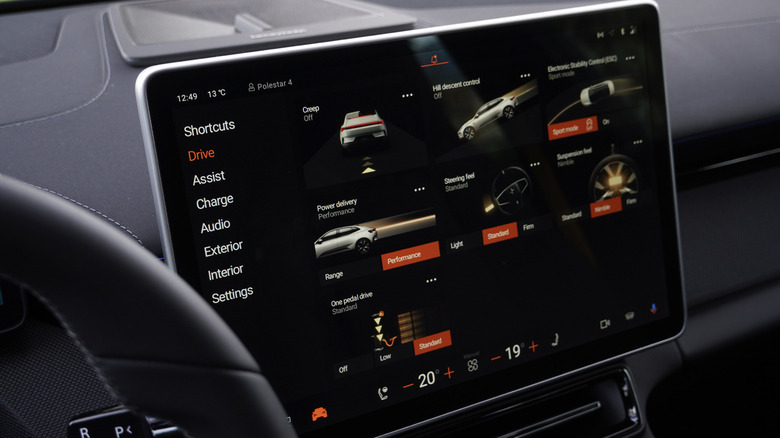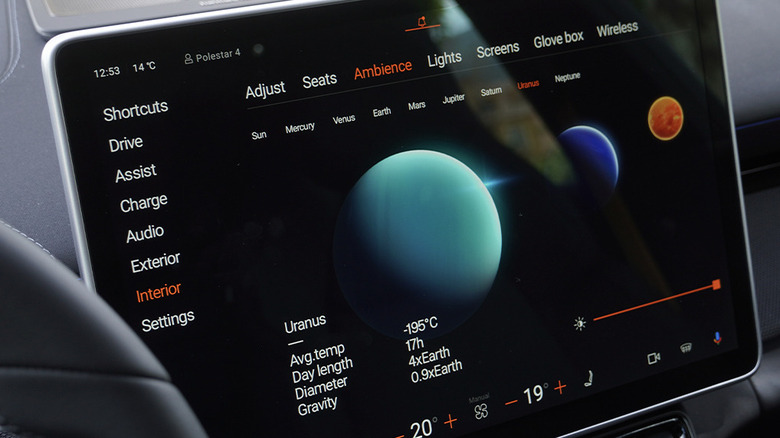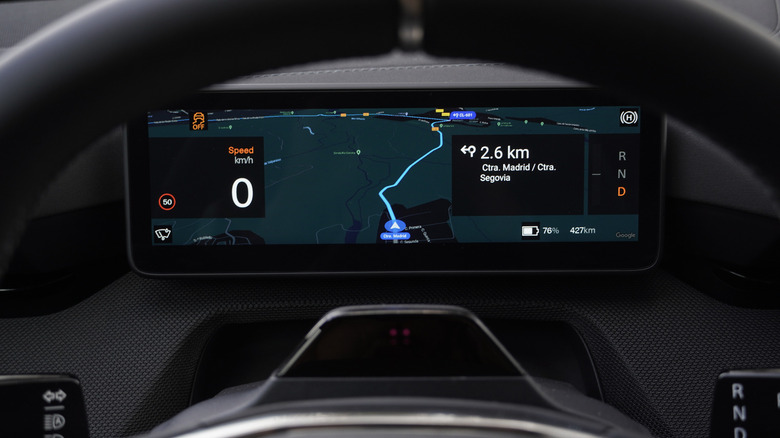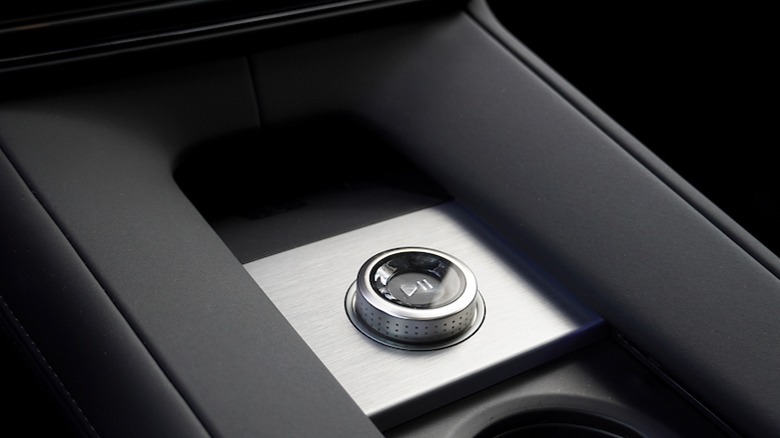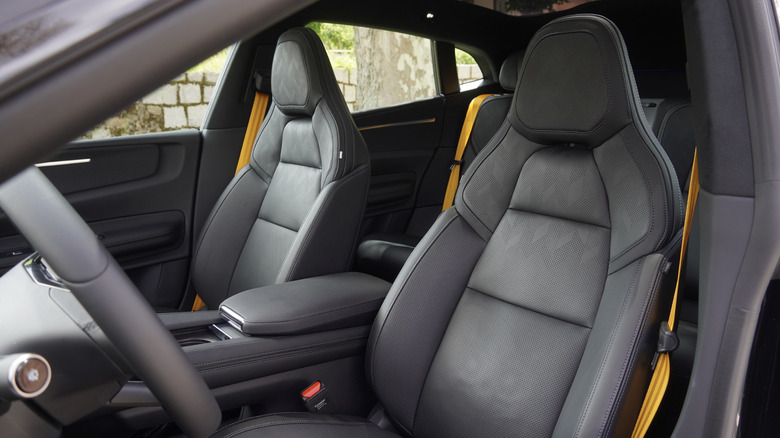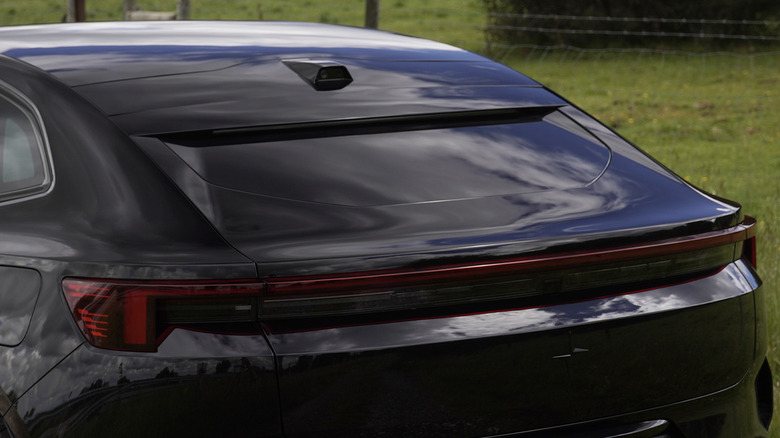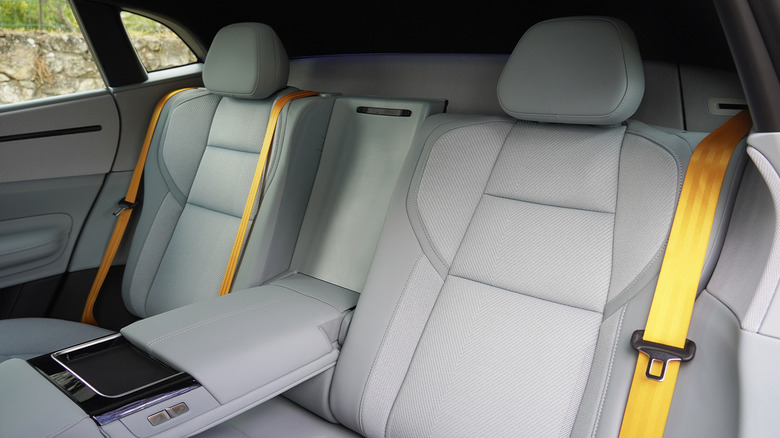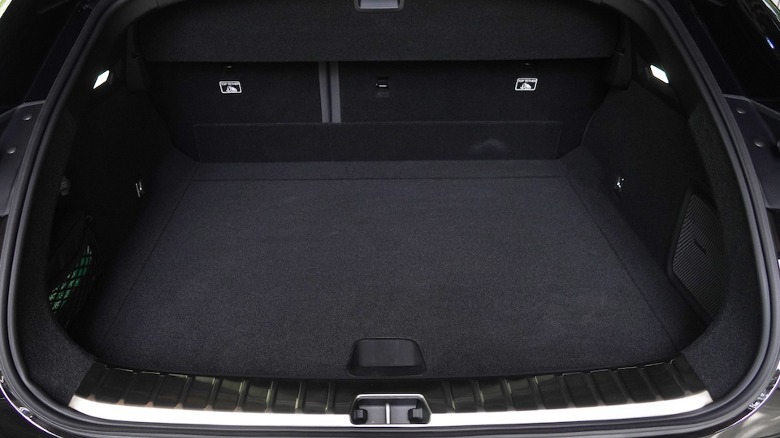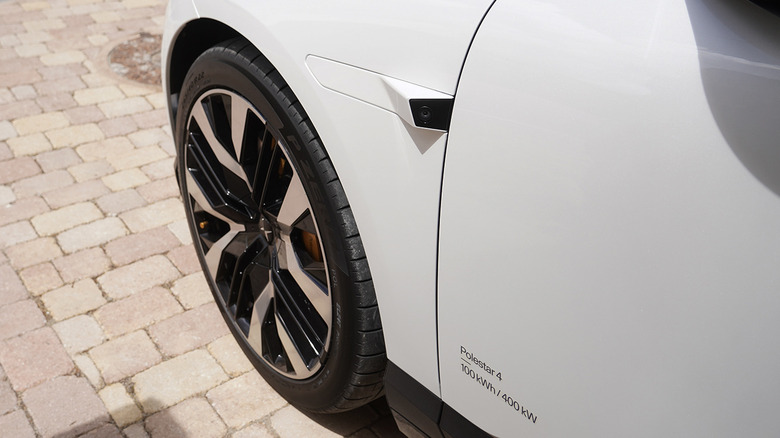2025 Polestar 4 First Drive: Can A Rear Window (Or Lack Thereof) Entirely Ruin A Car?
Later this year, Polestar will officially transition into a new era as a three-model manufacturer, when the 3 and 4 crossovers hit the American market for the 2025 model year. We've already reported on how the 2025 Polestar 3 aims to attract the largest potential customer base with all the performance, range, and luxury features to almost perfectly target buyers in the United States.
The 2025 Polestar 4 arrives riding on an underlying chassis shared with the Geely conglomerate, but with more power lurking beneath a lower and leaner exterior design. But that lower and leaner shape, in this case, was made possible by deleting the rear window entirely, a controversial decision that made a recent drive program in Madrid for both the 3 and 4 all the more interesting.
Polestar 4 specs and stats
Polestar decided to offer the 4 in two specs, either Long Range Single Motor or Long Range Dual Motor. The former uses one 200-kilowatt motor between the rear wheels to produce 272 horsepower and 253 lb-ft of torque, with a range target of 300 miles—the latter essentially doubles up with another 200-kilowatt motor at the front, good for 544 horsepower and 506 lb-ft of torque. Range drops to 270 miles for the Dual Motor, but a 0-60 sprint also drops from 6.9 seconds to 3.7 seconds, while base pricing jumps from $54,900 to $62,900.
Versus the 3, which comes only in all-wheel drive starting at $73,400 for the Long Range Dual Motor or $79,400 when equipped with the Performance Pack, the Long Range Dual Motor 4 boasts more horsepower but less torque. Overall height also drops 3.7 inches lower, and the design undoubtedly leans into a more muscular and athletic aesthetic than the more traditional proportions of the 3. The added power and improved aero also contribute to better acceleration stats, despite the 3's use of a torque vectoring and a disconnecting clutch for the rear motor.
But the sporty styling largely depends on the deleted rear window, which I wanted to check out in person to fully comprehend how this surprising decision actually survived through the R&D process to reach production after the 4's first-look debut back in fall of 2023.
A primer on digital rearview mirror technology
As Polestar reps repeatedly emphasized, deleting the rear window allowed the 4's C-pillar and roof bracing structure to scoot rearward. This creates additional headroom for the second row of seats, even allowing them to recline in luxurious fashion. Maximizing the interior volume of skateboard-battery EVs always requires a bit of imagination, but this radical take on the concept definitely required the additional explanations in Madrid.
Most importantly, the 4's lack of a rear window made a digital rearview mirror absolutely necessary, a piece of technology that I've increasingly experienced over the past few years mostly in General Motors pickup trucks and the C8 Corvette. At first, the digital screens in place of rearview mirrors left me baffled, but I quickly adjusted to the improved field of vision and reduced blind spots made possible by a wide-angle camera mounted on a vehicle's rear end. The main challenge to overcome involved teaching my eyes to make the depth perception change, from stereoscopic representation of distance in a mirror to focusing on the physical surface of the mirror-screen itself.
Gentex's second-generation mirror system
Before hopping into the 4 in Madrid traffic, Polestar reps also made sure to brief us journalists about how, exactly, the new digital rearview camera works. In this case, Polestar signed on Gentex, a mirror-camera system company that sold the first generation of its technology to many OEMs that installed it in over 125 models over the past few years. The Polestar 4 represents the second-gen camera's first application in a production vehicle, with a 2.5-megapixel resolution on a 1920x1280 pixel screen that can crop to improve specific viewing angles.
Unlike the Gentex systems on other cars, however–which, when turned off, then turn back into a real mirror with a view out of the rear window–in this case if the camera or screen potentially stops working, the 4 leaves the driver with a complete blind spot of the road behind them (though it'll give a glimpse of those in the back seat, at least). That obviously raises questions about Polestar's strategy if the hardware or software glitches, and if the camera gets blocked or dirty. For an automotive journalist already accustomed to digital rearview mirrors, the decision seems questionable enough. But what about for potential Polestar 4 buyers who have never used one before and drop into a "Space" retail location for a test drive?
Trading a rear window for additional space
As Polestar's presentation repeatedly pointed out, the entire goal of deleting the rear window and depending entirely on a camera and mirror-screen system came down to the lower roofline. Accordingly, the 4 looks more similar to Polestar's forthcoming flagship sedan—dubbed, as expected by now, the Polestar 5—or even, from certain angles, the muscular haunches and silhouette of a Porsche Taycan Cross Turismo mixed with a Kia EV6.
But the 4 radically undercuts both the 5 and Taycan in terms of pricing, even if with the Performance Pack installed on my test vehicle—and unlike the 3—power output does not increase. Instead, the 4's Performance Pack adds Brembo front brake calipers, 22-inch wheels, revised shock damper tuning, and sweet gold-finish seatbelts.
Differences between the Polestar 3 and 4
Nonetheless, as soon as I drove the 3 the next day, I understood how much more the 4 prioritizes the emphasis on more sporting driving dynamics. I wished that Polestar dropped us into the 3 first, in fact, because the 4's firmer suspension and steering combine with more power to reveal significant differences between the two models.
On the 3, for example, I preferred to keep the adjustable steering in Firm mode, but on the 4 I found that the additional assist of the Standard mode helped to reduce a tendency toward tramlining and torque steer. Hustling through corners, the 4's lower and firmer suspension undoubtedly felt more planted, but sharps stabs into the go pedal (can't call it a throttle on an EV, right?) produced a bit more of a negative reactionary response from the front tires.
Ambience based on astronomy (not astrology)
The 3 also felt lighter, and somehow more playful the next day. I began to suspect that the rear torque vectoring and clutch, as well as the softer suspension and lighter steering, actually helped the 3 send more feedback through my seat and steering wheel. And surprisingly, the taller 3 also manages a higher top speed of 130 miles per hour, versus the more powerful 4's max of 124. The mysteries deepen...
Speaking of the mysteries of the universe, the 4 also features a slightly more futuristic interior that includes an hilarious astronomy-based mood lighting system (note, that's not astrology, despite plenty of malapropisms during the presentation explaining the programming). Selecting between the sun and each planet in our solar system—Mercury, Venus, Earth, Mars... also most surprisingly, Uranus... Neptune, (but no Pluto!)—changes the ambience. A little graphic will even show an O₂ concept car flying through space, something of a little jab at Elon Musk, I figure.
Bigger is better when it comes to screens
On the same center infotainment screen, Polestar's use of Google tech for the native user interface provides crisp and clean tiles to drop into lower menus and change settings. A configurable shortcuts page helps to keep the system efficient, and activating wireless Apple CarPlay will not totally occupy the screen, either. But as on the 3, bringing navigation up on the main touchscreen will not show turn-by-turn directions. Instead, the turn-by-turn prompts pop up on the smaller gauge cluster screen, which at least on the 4 grows another 1.2 inches in size versus the 3.
At the end of the day, as I calculated the real-world range usage after pushing the Polestar 4 relatively hard, I also began to coalesce my thoughts on the lack of rear glass and total dependency on the digital rearview mirror. I had burned through 41% of claimed charge and 231 kilometers (143.5 miles) of range to travel 197 kilometers (122 miles) with the air conditioning, massaging seats, and music blasting.
The digital rearview mirror performs as intended, for better or worse
I wondered somewhat jokingly how much juice the rearview camera and digital mirror suck up. But more importantly, I thought the system works relatively well, all things considered. I purposefully checked resolution and clarity in the dark of a few long tunnels, but still wonder how well the full nighttime performance balances brightness and glare within the cabin with actual visibility. Even for my young eyes thankfully still managing 20/15 vision, last time I went to the eye doctor, using the digital mirror requires an adjustment. What about for those wearing glasses, contacts, or with older eyes ruined by a lifetime at the computer and unable to quickly focus or adapt to changes in ambient light?
Then there's backing up or reversing while turning to parallel park, even glancing over my shoulder just out of pure paranoia. And some of the programming also creates a lack of confidence, notably that the rearview mirror screen changes camera angles whenever the driver uses the turn signals. Unfortunately, this happens with a slight bit of lag, which meant that every time I went to glance in the mirror while preparing to change lanes, the view on the screen changed at that very moment—I couldn't help it, but my brain reacted each and every time as if the system was glitching, not purposefully performing as intended. And that momentary loss of confidence doesn't help build trust...
Solving problems that we created
Another questionable piece of software programming emerges from Polestar's obvious attempts to ameliorate the problems created by "solving" the lack of a rear window. Namely, that the main central touchscreen and gauge cluster also turn into camera displays with the turn signal on, replacing both the bird's eye and turn-by-turn navigation instructions simultaneously. For a foreigner driving on the tight, confusing streets of Madrid, losing my directions while coming up to a six-way intersection—all to compensate for the lack of visibility—probably created more unsafe maneuvers than I might have made while simply running blind out of the rear end.
Perhaps most baffling, the 4's exterior design actually includes a specific panel line on the rear hatch that looks exactly like a window, but is in fact painted over. That detail absolutely beggars belief. Couldn't we at least make that small opening out of glass? No, a Polestar rep informed me, because the ADAS system sensors live under there.
Is the tradeoff worth it?
So in the end, I left Madrid unconvinced that canceling the rear window to allow for a slightly lower roofline makes for a worthwhile trade. Sure, shifting the rear support bracing above the C-pillar allows for comfortable reclining rear seats, but that trends more toward chauffeur-y than sporty, the exact spirit on which the rest of the 4's characteristics specifically attempt to capitalize. And instead of maxing out the potential utility of the additional volume with a three-seat bench for the rear row or a larger trunk, instead Polestar stuck with recline only for the dual semi-buckets and a smaller trunk.
After driving both the 4 and the 3, I began to wonder why Polestar decided to build the 4 in the first place. This sleeker crossover slots in below the 3's price point, but puts out more power and features more futuristic tech. And yet the more upright 3 actually arrives with the more communicative and enjoyable chassis tuning, which somewhat clashes with the divergent designs of two vehicles built on the same platform. So why offer both, rather than simply a more powerful version of the 3 with tighter suspension—other than to keep up the numerical nomenclature.
Futuristic tech for the first adopters
The fact that a first drive review comes mostly down to a single decision will no doubt leave Polestar execs, designers, engineers, and PR pros somewhat frustrated. Yet I suspect the drive program in Madrid purposefully put us in the 3 second so that we might head home with better recent memories. Similarly to that choice, boldly eschewing a rear window will undoubtedly either turn off potential buyers or turn on those early tech adopters who crave the most radical features in the name of living the avant-garde lifestyle.
In my opinion, the 4 represents the first hiccup from Polestar as a brand since the spinoff from Volvo and production beginning under Geely oversight. Regardless, simultaneously adding two crossovers to the lineup should help to boost the company's recognition and marketing position. And, hopefully, thereby bolster overall sales, since I still view Polestar as one of my favorite automakers at the current moment, in terms of design, performance, and sustainability efforts alike.
Given the 4's obvious shortcomings, though, I suspect the 3–even at a significantly higher price point–will end up making the largest difference, as Polestar continues to expand its footprint here in the United States and abroad.
